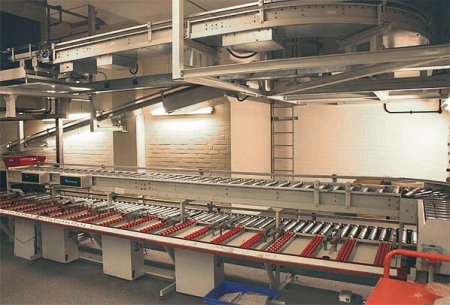Easter is the busiest time of the year at the British Library (so be warned if you are expecting a quiet space to do your research). In order to help cope with the volume of requests for books from our capacious basements in St Pancras, staff volunteers are requested.
 As a member of staff who rarely visits the basements this is an opportunity not to be missed. After all, the basements are the very foundation of the library, from both a physical and information perspective. The four double height basements containing the bulk of the library’s 15 million books stretch down to 75ft or 23m below ground level. The construction of these required digging the deepest hole ever seen in London. I could hear the nearby sounds of trains on the Northern and Victoria Lines when I was in basement 3.
As a member of staff who rarely visits the basements this is an opportunity not to be missed. After all, the basements are the very foundation of the library, from both a physical and information perspective. The four double height basements containing the bulk of the library’s 15 million books stretch down to 75ft or 23m below ground level. The construction of these required digging the deepest hole ever seen in London. I could hear the nearby sounds of trains on the Northern and Victoria Lines when I was in basement 3.
I spent a fascinating couple of hours re-shelving books in the humanities modern section. However, my trolley contained a random selection of topics giving a revealing glimpse into the subjects being researched above ground, as well as the incredible breadth of knowledge stored below ground.
 One fact that often surprises visitors to the basements is that the books are not stored according to any classification system. Although the British Library has adopted the Dewey system in the Reading Rooms, this would not work in the basements. The explanation is simple enough – the sheer volume of new books (6 miles or 13 kilometres) each year means that they have to be added onto the end of the previous set in acquisition order. Any other would require constant shifting of the book stock to make room.
One fact that often surprises visitors to the basements is that the books are not stored according to any classification system. Although the British Library has adopted the Dewey system in the Reading Rooms, this would not work in the basements. The explanation is simple enough – the sheer volume of new books (6 miles or 13 kilometres) each year means that they have to be added onto the end of the previous set in acquisition order. Any other would require constant shifting of the book stock to make room.
So, for instance if they were in alphabetical order by Title, the Z’s would slot nicely in at the end of the sequence but any new A’s would require moving the whole lot. This results in some vary odd pairings of books on the shelves. I re-shelved a book on Islamic terrorism literally cheek by jowl with a volume on right-wing Jewish politics.
The photos above come from a website Subterranea Britannica which has a detailed article on a visit to the basements.
 The British Library has always had a strong fan base, particularly when our funding seemed to be threatened. However it is great to see a new fan in the shape of Liz Joseph an inventor. She has started a brand new blog to follow her journey of discovery as she develops her mass-market product.
The British Library has always had a strong fan base, particularly when our funding seemed to be threatened. However it is great to see a new fan in the shape of Liz Joseph an inventor. She has started a brand new blog to follow her journey of discovery as she develops her mass-market product.









 As I mentioned in my previous blog post on our first
As I mentioned in my previous blog post on our first  Although I felt I rambled on a bit, Alex seems to have kept most of the interview in the final edit. It is a mixture of chat about the Business & IP Centre and the role of Facebook and blogs to promote it to a new audience.
Although I felt I rambled on a bit, Alex seems to have kept most of the interview in the final edit. It is a mixture of chat about the Business & IP Centre and the role of Facebook and blogs to promote it to a new audience.
